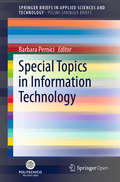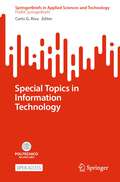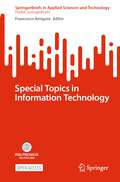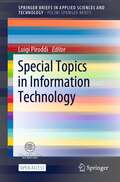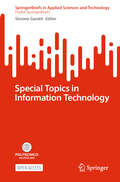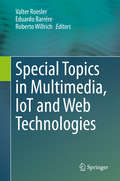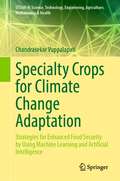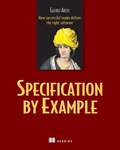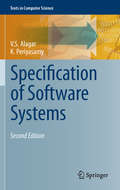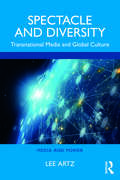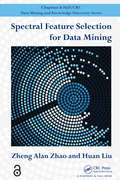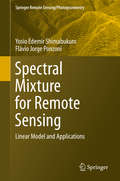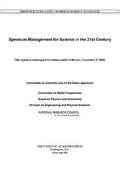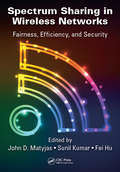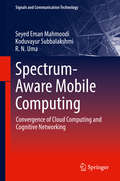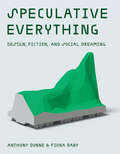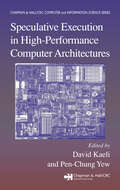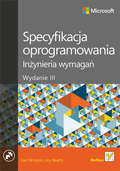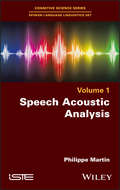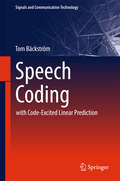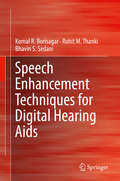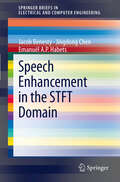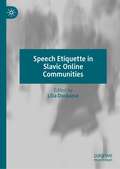- Table View
- List View
Special Topics in Information Technology (SpringerBriefs in Applied Sciences and Technology)
by Barbara PerniciThis open access book presents nine outstanding doctoral dissertations in Information Technology from the Department of Electronics, Information and Bioengineering, Politecnico di Milano, Italy. Information Technology has always been highly interdisciplinary, as many aspects have to be considered in IT systems. The doctoral studies program in IT at Politecnico di Milano emphasizes this interdisciplinary nature, which is becoming more and more important in recent technological advances, in collaborative projects, and in the education of young researchers. Accordingly, the focus of advanced research is on pursuing a rigorous approach to specific research topics starting from a broad background in various areas of Information Technology, especially Computer Science and Engineering, Electronics, Systems and Controls, and Telecommunications. Each year, more than 50 PhDs graduate from the program. This book gathers the outcomes of the nine best theses defended in 2018-19 and selected for the IT PhD Award. Each of the nine authors provides a chapter summarizing his/her findings, including an introduction, description of methods, main achievements and future work on the topic. Hence, the book provides a cutting-edge overview of the latest research trends in Information Technology at Politecnico di Milano, presented in an easy-to-read format that will also appeal to non-specialists.
Special Topics in Information Technology (SpringerBriefs in Applied Sciences and Technology)
by Carlo G. RivaThis open access book presents outstanding doctoral dissertations in Information Technology from the Department of Electronics, Information and Bioengineering, Politecnico di Milano, Italy. Information Technology has always been highly interdisciplinary, as many aspects have to be considered in IT systems. The doctoral studies program in IT at Politecnico di Milano emphasizes this interdisciplinary nature, which is becoming more and more important in recent technological advances, in collaborative projects, and in the education of young researchers.Accordingly, the focus of advanced research is on pursuing a rigorous approach to specific research topics starting from a broad background in various areas of Information Technology, especially Computer Science and Engineering, Electronics, Systems and Control, and Telecommunications.Each year, more than 50 PhDs graduate from the program. This book gathers the outcomes of the best theses defended in 2021-22 and selected for the IT PhD Award. Each of the authors provides a chapter summarizing his/her findings, including an introduction, description of methods, main achievements and future work on the topic. Hence, the book provides a cutting-edge overview of the latest research trends in Information Technology at Politecnico di Milano, presented in an easy-to-read format that will also appeal to non-specialists.
Special Topics in Information Technology (SpringerBriefs in Applied Sciences and Technology)
by Francesco AmigoniThis open access book presents outstanding doctoral dissertations in Information Technology from the Department of Electronics, Information and Bioengineering, Politecnico di Milano, Italy. Information Technology has always been highly interdisciplinary, as many aspects have to be considered in IT systems. The doctoral studies program in IT at Politecnico di Milano emphasizes this interdisciplinary nature, which is becoming more and more important in recent technological advances, in collaborative projects, and in the education of young researchers. Accordingly, the focus of advanced research is on pursuing a rigorous approach to specific research topics starting from a broad background in various areas of Information Technology, especially Computer Science and Engineering, Electronics, Systems and Control, and Telecommunications. Each year, more than 50 Ph.D.s. graduate from the program. This book gathers the outcomes of the best theses defended in 2022–23 and selected for the IT Ph.D. Award. Each of the authors provides a chapter summarizing his/her findings, including an introduction, description of methods, main achievements and future work on the topic. Hence, the book provides a cutting-edge overview of the latest research trends in Information Technology at Politecnico di Milano, presented in an easy-to-read format that will also appeal to non-specialists.
Special Topics in Information Technology (SpringerBriefs in Applied Sciences and Technology)
by Luigi PiroddiThis open access book presents thirteen outstanding doctoral dissertations in Information Technology from the Department of Electronics, Information and Bioengineering, Politecnico di Milano, Italy. Information Technology has always been highly interdisciplinary, as many aspects have to be considered in IT systems. The doctoral studies program in IT at Politecnico di Milano emphasizes this interdisciplinary nature, which is becoming more and more important in recent technological advances, in collaborative projects, and in the education of young researchers.Accordingly, the focus of advanced research is on pursuing a rigorous approach to specific research topics starting from a broad background in various areas of Information Technology, especially Computer Science and Engineering, Electronics, Systems and Control, and Telecommunications.Each year, more than 50 PhDs graduate from the program. This book gathers the outcomes of the thirteen best theses defended in 2020-21 and selected for the IT PhD Award. Each of the authors provides a chapter summarizing his/her findings, including an introduction, description of methods, main achievements and future work on the topic. Hence, the book provides a cutting-edge overview of the latest research trends in Information Technology at Politecnico di Milano, presented in an easy-to-read format that will also appeal to non-specialists.
Special Topics in Information Technology (SpringerBriefs in Applied Sciences and Technology)
by Simone GarattiThis open access book presents outstanding doctoral dissertations in Information Technology from the Department of Electronics, Information, and Bioengineering, Politecnico di Milano, Italy. Information technology has always been highly interdisciplinary, as many aspects have to be considered in IT systems. The doctoral studies program in IT at Politecnico di Milano emphasizes this interdisciplinary nature, which is becoming more and more important in recent technological advances, in collaborative projects, and in the education of young researchers. Accordingly, the focus of advanced research is on pursuing a rigorous approach to specific research topics starting from a broad background in various areas of Information Technology, especially computer science and engineering, electronics, systems and control, and telecommunications. Each year, more than 50 Ph.Ds. graduate from the program. This book gathers the outcomes of the best theses defended in 2023–24 and selected for the IT Ph.D. award. Each of the authors provides a chapter summarizing his/her findings, including an introduction, description of methods, main achievements, and future work on the topic. Hence, the book provides a cutting-edge overview of the latest research trends in information technology at Politecnico di Milano, presented in an easy-to-read format that will also appeal to non-specialists.
Special Topics in Multimedia, IoT and Web Technologies
by Valter Roesler Eduardo Barrére Roberto WillrichThis book presents a set of recent advances that involve the areas of multimedia, IoT, and web technologies. These advances incorporate aspects of clouds, artificial intelligence, data analysis, user experience, and games. In this context, the work will bring the reader the opportunity to understand new possibilities of use and research in these areas. We think that this book is suitable for students (postgraduates and undergraduates) and lecturers on these specific topics. Professionals can also benefit from the book since some chapters work with practical aspects relevant to the industry.
Specialty Crops for Climate Change Adaptation: Strategies for Enhanced Food Security by Using Machine Learning and Artificial Intelligence (STEAM-H: Science, Technology, Engineering, Agriculture, Mathematics & Health)
by Chandrasekar VuppalapatiSpecialty crops are defined as fruits and vegetables, tree nuts, dried fruits, horticulture, and nursery crops including floriculture. The value of specialty crop production in the United States accounted for 18.44 % of the $433.569 billion in agriculture cash receipts collected in 2021. In 2020, that ratio was 21.47% of the $363.464 billion. Specialty crops are gaining increasing attention across nation as demonstrated in the 2018 farm bill (Agricultural Act of the 2018 Farm Bill (P.L. 115-334)) with the increased number of provisions addressing specialty crop issues, reflecting their growing role in the global economy. The cultivation of Specialty crops, nevertheless, has its own challenges. Specialty crops are generally more sensitive to climatic stressors and require more comprehensive management compared to traditional row crops. Specialty crops face significant financial risks threatening US$1.6 Trillion global market due to their higher water demand. The mission of the book is to prepare current and future software engineering teams, agriculture students, economists, macroeconomists with the skills and tools to fully utilize advanced data science, artificial intelligence, climate patterns, and economic models to develop software capabilities that help to achieve Specialty crops and economic sustainability, through improved productivity for years to come and ensure enough food for the future of the planet and generations to come!
Specification by Example: How Successful Teams Deliver the Right Software
by Gojko AdzicSummary Specification by Example is an emerging practice for creating software based on realistic examples, bridging the communication gap between business stakeholders and the dev teams building the software. In this book, author Gojko Adzic distills interviews with successful teams worldwide, sharing how they specify, develop, and deliver software, without defects, in short iterative delivery cycles. About the Technology Specification by Example is a collaborative method for specifying requirements and tests. Seven patterns, fully explored in this book, are key to making the method effective. The method has four main benefits: it produces living, reliable documentation; it defines expectations clearly and makes validation efficient; it reduces rework; and, above all, it assures delivery teams and business stakeholders that the software that's built is right for its purpose. About the Book This book distills from the experience of leading teams worldwide effective ways to specify, test, and deliver software in short, iterative delivery cycles. Case studies in this book range from small web startups to large financial institutions, working in many processes including XP, Scrum, and Kanban. This book is written for developers, testers, analysts, and business people working together to build great software. Purchase of the print book comes with an offer of a free PDF, ePub, and Kindle eBook from Manning. Also available is all code from the book. What's Inside Common process patterns How to avoid bad practices Fitting SBE in your process 50+ case studies =============================================== Table of Contents Part 1 Getting started Part 2 Key process patterns Part 3 Case studies Key benefits Key process patterns Living documentation Initiating the changes Deriving scope from goals Specifying collaboratively Illustrating using examples Refining the specification Automating validation without changing specifications Validating frequently Evolving a documentation system uSwitch RainStor Iowa Student Loan Sabre Airline Solutions ePlan Services Songkick Concluding thoughts
Specification of Software Systems
by V. S. Alagar K. PeriyasamyThis extensively revised and updated new edition of Specification of Software Systems builds upon the original focus on software specification with added emphasis on the practice of formal methods for specification and verification activities for different types of software systems and at different stages of developing software systems. Topics and features: provides a wide coverage of formal specification techniques and a clear writing style, supported by end-of-chapter bibliographic notes for further reading; presents a logical structure, with sections devoted to specification fundamentals, basics of formalism, logic, set theory and relations, property-oriented specification methods, and model-based specification techniques; contains end-of-chapter exercises and numerous case studies, with potential course outlines suggested in the Preface; covers Object-Z, B-Method, and Calculus of Communicating Systems; offers material that can be taught with tool-supported laboratory projects.
Speckle Imaging Using Aperture Modulation (SpringerBriefs in Applied Sciences and Technology)
by Abdallah HamedThis book covers speckle image formation using a variety of modulated apertures. The central theme revolves around theoretical analyses, specifically the calculation of impulse responses or Point Spread Functions (PSFs) corresponding to these apertures. These calculations provide crucial insights into the resolution inherent in the resulting speckle images. The book begins with an examination of the recognition of the direction of new apertures from elongated speckle images, setting the stage for subsequent discussions. The theoretical analyses extend to diverse aperture designs, including Gaussian, graded-index, and modulated apertures. The book delves into the nuanced dynamics of contrast in speckle images, exploring the Voigt distribution and the effects of modulation on contrast. In addition to aperture-centric discussions, the book addresses the processing of the formed speckle images. The chapters impart a comprehensive understanding of speckle imaging, encompassing discrimination in microscopy using digital speckle images, the utilization of concentric hexagonal pupils, and the exploration of irregular apertures. The book culminates in a detailed exploration of speckle imaging in the context of an annular Hermite Gaussian laser beam. Overall, this book serves as a valuable resource for researchers and academics seeking a profound exploration of speckle image formation, modulation, and processing across a spectrum of apertures and theoretical frameworks.
Spectacle and Diversity: Transnational Media and Global Culture (ISSN)
by Lee ArtzThis book shows how transnational media operate in the contemporary world and what their impact is on film, television, and the larger global culture. Where a company is based geographically no longer determines its outreach or output. As media consolidate and partner across national and cultural boundaries, global culture evolves. The new transnational media industry is universal in its operation, function, and social impact. It reflects a shared transnational culture of consumerism, authoritarianism, cultural diversity, and spectacle. From Wolf Warriors and Sanju to Valerian: City of 1000 Planets and Pokémon, new media combinations challenge old assumptions about cultural imperialism and reflect cross-boundary collaboration as well as boundary-breaking cultural interpretation. Intended for students of global studies and international communication at all levels, the book will appeal to a wide range of readers interested in the way transnational media work and how that shapes our culture.
Spectacle and Diversity: Transnational Media and Global Culture (Media and Power)
by Lee Burton ArtzThis book shows how transnational media operate in the contemporary world and what their impact is on film, television, and the larger global culture. Where a company is based geographically no longer determines its outreach or output. As media consolidate and partner across national and cultural boundaries, global culture evolves. The new transnational media industry is universal in its operation, function, and social impact. It reflects a shared transnational culture of consumerism, authoritarianism, cultural diversity, and spectacle. From Wolf Warriors and Sanju to Valerian: City of 1000 Planets and Pokémon, new media combinations challenge old assumptions about cultural imperialism and reflect cross-boundary collaboration as well as boundary-breaking cultural interpretation. Intended for students of global studies and international communication at all levels, the book will appeal to a wide range of readers interested in the way transnational media work and how that shapes our culture.
Spectral Feature Selection for Data Mining (Chapman And Hall/crc Data Mining And Knowledge Discovery Ser.)
by Huan Liu Zheng Alan ZhaoSpectral Feature Selection for Data Mining introduces a novel feature selection technique that establishes a general platform for studying existing feature selection algorithms and developing new algorithms for emerging problems in real-world applications. This technique represents a unified framework for supervised, unsupervised, and semisupervise
Spectral Mixture for Remote Sensing: Linear Model and Applications (Springer Remote Sensing/Photogrammetry)
by Yosio Edemir Shimabukuro Flávio Jorge PonzoniThis book explains in a didactic way the basic concepts of spectral mixing, digital numbers and orbital sensors, and then presents the linear modelling technique of spectral mixing and the generation of fractional images. In addition to presenting a theoretical basis for spectral mixing, the book provides examples of practical applications such as projects for estimating and monitoring deforested areas in the Amazon. In its seven chapters, the book offers remote sensing techniques to understand the main concepts, methods, and limitations of spectral mixing for digital image processing. Chapter 1 addresses the basic concepts of spectral mixing, while chapters 2 and 3 discuss digital numbers and orbital sensors such as MODIS and Landsat MSS. Chapter 4 details the linear spectral mixing model, and chapter 5 talks about how to use this technique to create fraction images. Chapter 6 offers remote sensing applications of fraction images in deforestation monitoring, burned-area mapping, selective logging detection, and land-use/land-cover mapping. Chapter 7 gives some concluding thoughts on spectral mixing, and considers future uses in environmental remote sensing. This book will be of interest to students, teachers, and researchers using remote sensing for Earth observation and environmental modelling.
Spectrum Management for Science in the 21st Century
by National Research Council of the National AcademiesRadio observations of the cosmos are gathered by geoscientists using complex earth-orbiting satellites and ground-based equipment, and by radio astronomers using large ground-based radio telescopes. Signals from natural radio emissions are extremely weak, and the equipment used to measure them is becoming ever-more sophisticated and sensitive. The radio spectrum is also being used by radiating, or "active," services, ranging from aircraft radars to rapidly expanding consumer services such as cellular telephones and wireless internet. These valuable active services transmit radio waves and thereby potentially interfere with the receive-only, or "passive," scientific services. Transmitters for the active services create an artificial "electronic fog" which can cause confusion, and, in severe cases, totally blinds the passive receivers. Both the active and the passive services are increasing their use of the spectrum, and so the potential for interference, already strong, is also increasing. This book addresses the tension between the active services' demand for greater spectrum use and the passive users' need for quiet spectrum. The included recommendations provide a pathway for putting in place the regulatory mechanisms and associated supporting research activities necessary to meet the demands of both users.
Spectrum Sharing in Wireless Networks: Fairness, Efficiency, and Security
by John D. Matyjas, Sunil Kumar and Fei HuSpectrum Sharing in Wireless Networks: Fairness, Efficiency, and Security provides a broad overview of wireless network spectrum sharing in seven distinct sections: The first section examines the big picture and basic principles, explaining the concepts of spectrum sharing, hardware/software function requirements for efficient sharing, and future trends of sharing strategies. The second section contains more than 10 chapters that discuss differing approaches to efficient spectrum sharing. The authors introduce a new coexistence and sharing scheme for multi-hop networks, describe the space-time sharing concept, introduce LTE-U, and examine sharing in broadcast and unicast environments. They then talk about different cooperation strategies to achieve mutual benefits for primary users (PU) and secondary users (SU), discuss protocols in a spectrum sharing context, and provide different game theory models between PUs and SUs. The third section explains how to model the interactions of PUs and SUs, using an efficient calculation method to determine spectrum availability. Additionally, this section explains how to use scheduling models to achieve efficient SU traffic delivery. The subject of the fourth section is MIMO-oriented design. It focuses on how directional antennas and MIMO antennas greatly enhance wireless network performance. The authors include a few chapters on capacity/rate calculations as well as beamforming issues under MIMO antennas. Power control is covered in the fifth section which also describes the interference-aware power allocation schemes among cognitive radio users and the power control schemes in cognitive radios. The sixth section provides a comprehensive look at security issues, including different types of spectrum sharing attacks and threats as well as corresponding countermeasure schemes. The seventh and final section covers issues pertaining to military applications and examines how the military task protects its data flows when sharing the spectrum with civilian applications.
Spectrum-Aware Mobile Computing: Convergence of Cloud Computing and Cognitive Networking (Signals and Communication Technology)
by R. N. Uma Seyed Eman Mahmoodi Koduvayur SubbalakshmiThis book presents solutions to the problems arising in two trends in mobile computing and their intersection: increased mobile traffic driven mainly by sophisticated smart phone applications; and the issue of user demand for lighter phones, which cause more battery power constrained handhelds to offload computations to resource intensive clouds (the second trend exacerbating the bandwidth crunch often experienced over wireless networks). The authors posit a new solution called spectrum aware cognitive mobile computing, which uses dynamic spectrum access and management concepts from wireless networking to offer overall optimized computation offloading and scheduling solutions that achieve optimal trade-offs between the mobile device and wireless resources. They show how in order to allow these competing goals to meet in the middle, and to meet the promise of 5G mobile computing, it is essential to consider mobile offloading holistically, from end to end and use the power of multi-radio access technologies that have been recently developed. Technologies covered in this book have applications to mobile computing, edge computing, fog computing, vehicular communications, mobile healthcare, mobile application developments such as augmented reality, and virtual reality.
Speculative Everything: Design, Fiction, and Social Dreaming
by Anthony Dunne Fiona RabyHow to use design as a tool to create not only things but ideas, to speculate about possible futures.Today designers often focus on making technology easy to use, sexy, and consumable. In Speculative Everything, Anthony Dunne and Fiona Raby propose a kind of design that is used as a tool to create not only things but ideas. For them, design is a means of speculating about how things could be—to imagine possible futures. This is not the usual sort of predicting or forecasting, spotting trends and extrapolating; these kinds of predictions have been proven wrong, again and again. Instead, Dunne and Raby pose “what if” questions that are intended to open debate and discussion about the kind of future people want (and do not want).Speculative Everything offers a tour through an emerging cultural landscape of design ideas, ideals, and approaches. Dunne and Raby cite examples from their own design and teaching and from other projects from fine art, design, architecture, cinema, and photography. They also draw on futurology, political theory, the philosophy of technology, and literary fiction. They show us, for example, ideas for a solar kitchen restaurant; a flypaper robotic clock; a menstruation machine; a cloud-seeding truck; a phantom-limb sensation recorder; and devices for food foraging that use the tools of synthetic biology. Dunne and Raby contend that if we speculate more—about everything—reality will become more malleable. The ideas freed by speculative design increase the odds of achieving desirable futures.
Speculative Execution in High Performance Computer Architectures (Chapman & Hall/CRC Computer and Information Science Series)
by Pen-Chung Yew David KaeliUntil now, there were few textbooks that focused on the dynamic subject of speculative execution, a topic that is crucial to the development of high performance computer architectures. Speculative Execution in High Performance Computer Architectures describes many recent advances in speculative execution techniques. It covers cutting-edge research
Specyfikacja oprogramowania. In?ynieria wymaga?. Wydanie III
by Karl E Wiegers Joy BeattyZebranie i opracowanie wymaga? dotycz?cych tworzonego oprogramowania to jeden z fundamentów udanego projektu. Znajomo?? zakresu prac jest kluczow? informacj? dla wszystkich osób prowadz?cych projekt oraz bezcennym ?ród?em wiedzy dla deweloperów tworz?cych kod. Brzmi prosto, ale wcale tak nie jest! Identyfikacja interesariuszy, dokumentacja wymaga?, okre?lanie ich warto?ci biznesowej — to tylko niektóre z wyzwa? stoj?cych przed analitykami i ich zespo?ami!Si?gnij po t? ksi??k?, by unikn?? typowych problemów i pu?apek. W kolejnych rozdzia?ach znajdziesz kluczowe informacje na temat wymaga? dotycz?cych oprogramowania, roli analityka biznesowego oraz dobrych praktyk w in?ynierii wymaga?. Cz??? II tej ksi??ki zosta?a po?wi?cona opracowywaniu wymaga?. Dowiedz si?, jak okre?la? wymagania biznesowe, rozmawia? z u?ytkownikami oraz dokumentowa? i walidowa? wymagania. W prawdziwym ?wiecie spotkasz si? z ró?nymi typami projektów. W zale?no?ci od ich charakteru trzeba b?dzie na bie??co dostosowywa? poznane techniki. Projekty zwinne, projekty systemów wbudowanych, automatyzacja procesów biznesowych to tylko cz??? z omawianych obszarów. Ksi??ka ta jest klasycznym podr?cznikiem, obowi?zkow? lektur? ka?dego analityka oraz osób odpowiedzialnych za wymagania.Dzi?ki tej ksi??ce:- nauczysz si? identyfikowa? interesariuszy oraz rozmawia? z klientami- poznasz dobre praktyki w in?ynierii wymaga?- zrozumiesz zadania analityka biznesowego- ograniczysz ryzyko dzi?ki prototypowaniu- poznasz projekty ró?nego typu- zrozumiesz proces zarz?dzania wymaganiamiLektura obowi?zkowa ka?dego analityka i osób odpowiedzialnych za wymagania!
Speech Acoustic Analysis
by Philippe MartinThe text sets out in simple and accessible terms the various methods of acoustic analysis of speech, placing them in their historical context, allowing a better understanding of the mathematical and technical solutions adopted today in phonetics and experimental phonology. Without mathematical complications, the operating bases of the many speech analysis software currently available are exposed so that everyone can understand the limits and avoid errors and misinterpretations in their implementation.
Speech Coding
by Tom BäckströmThis book provides scientific understanding of the most central techniques used in speech coding both for advanced students as well as professionals with a background in speech audio and or digital signal processing. It provides a clear connection between the Why’s?, How’s?, and What’s, such that the necessity, purpose and solutions provided by tools should be always within sight, as well as their strengths and weaknesses in each respect. Equivalently, this book sheds light on the following perspectives for each technology presented: Objective: What do we want to achieve and especially why is this goal important? Resource / Information: What information is available and how can it be useful? Resource / Platform: What kind of platforms are we working with and what are the capabilities/restrictions of those platforms? This includes properties such as computational, memory, acoustic and transmission capacity of devices used. Solutions: Which solutions have been proposed and how can they be used to reach the stated goals? Strengths and weaknesses: In which ways do the solutions fulfill the objectives and where are they insufficient? Are resources used efficiently? This book concentrates solely on code excited linear prediction and its derivatives since mainstream speech codecs are based on linear prediction It also concentrates exclusively on time domain techniques because frequency domain tools are to a large extent common with audio codecs.
Speech Enhancement Techniques for Digital Hearing Aids
by Rohit M. Thanki Komal R. Borisagar Bhavin S. SedaniThis book provides various speech enhancement algorithms for digital hearing aids. It covers information on noise signals extracted from silences of speech signal. The description of the algorithm used for this purpose is also provided. Different types of adaptive filters such as Least Mean Squares (LMS), Normalized LMS (NLMS) and Recursive Lease Squares (RLS) are described for noise reduction in the speech signals. Different types of noises are taken to generate noisy speech signals, and therefore information on various noises signals is provided. The comparative performance of various adaptive filters for noise reduction in speech signals is also described. In addition, the book provides a speech enhancement technique using adaptive filtering and necessary frequency strength enhancement using wavelet transform as per the requirement of audiogram for digital hearing aids.Presents speech enhancement techniques for improving performance of digital hearing aids;Covers various types of adaptive filters and their advantages and limitations;Provides a hybrid speech enhancement technique using wavelet transform and adaptive filters.
Speech Enhancement in the STFT Domain
by Jacob Benesty Jingdong Chen Emanuël A.P. HabetsThis work addresses this problem in the short-time Fourier transform (STFT) domain. We divide the general problem into five basic categories depending on the number of microphones being used and whether the interframe or interband correlation is considered. The first category deals with the single-channel problem where STFT coefficients at different frames and frequency bands are assumed to be independent. In this case, the noise reduction filter in each frequency band is basically a real gain. Since a gain does not improve the signal-to-noise ratio (SNR) for any given subband and frame, the noise reduction is basically achieved by liftering the subbands and frames that are less noisy while weighing down on those that are more noisy. The second category also concerns the single-channel problem. The difference is that now the interframe correlation is taken into account and a filter is applied in each subband instead of just a gain. The advantage of using the interframe correlation is that we can improve not only the long-time fullband SNR, but the frame-wise subband SNR as well. The third and fourth classes discuss the problem of multichannel noise reduction in the STFT domain with and without interframe correlation, respectively. In the last category, we consider the interband correlation in the design of the noise reduction filters. We illustrate the basic principle for the single-channel case as an example, while this concept can be generalized to other scenarios. In all categories, we propose different optimization cost functions from which we derive the optimal filters and we also define the performance measures that help analyzing them.
Speech Etiquette in Slavic Online Communities
by Lilia DuskaevaThis edited book focuses on speech etiquette, examining the rules that govern communication in various online communities: professional, female, and ethnospecific. The contributors analyze online communication in the Slavic languages Russian, Slovak, Polish, and Belarusian, showing how the concept of speech etiquette differs from the concept of politeness, although both reflect the relationship between people in interaction. Online communities are united on the basis of common informative or phatic illocutions among their participants, and their speech etiquette is manifested in stable forms of conducting discussions – stimulating and responding. Each group has its own ideas of unacceptable speech behavior and approaches to sanitation, and the rules of speech etiquette in each group determine the degree of rapport and distancing between the participants in discourse. The chapters in this book explore how rapport and distance are established through acts such as showing attention to the addressee and increasing his or her communicative status; reducing or increasing the illocutionary power of evaluations and motivations; and evaluating one’s own or someone else’s speech. The volume will be of interest to researchers studying online communication in such diverse fields as linguistics, sociology, anthropology, programming, and media studies.
